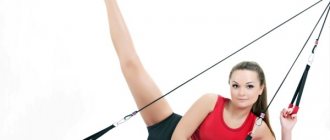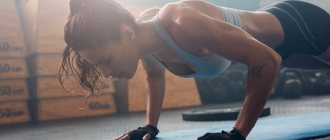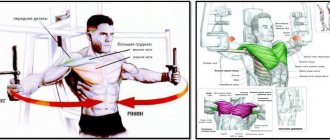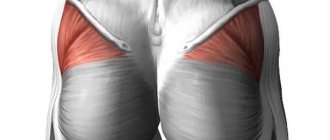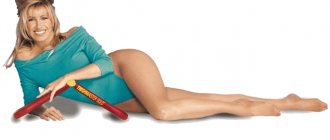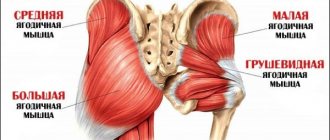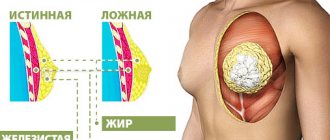A crossover is a universal exercise machine with a large number of functions that allow you to perform physical exercises to pump up the muscles of the shoulder girdle, back, buttocks, chest and legs.
This sports equipment is especially popular among girls who want to get rid of excess weight, make their body drier and more prominent. The crossover is a convenient exercise machine with upper and lower blocks that are designed for the development of all skeletal muscle groups.
Advantages and features of the crossover simulator
Crossover exercises can be performed independently or under the guidance of an instructor. A distinctive feature of this simulator is that with the help of its blocks it will be possible to develop not only the back, but also all parts of the musculoskeletal system.
The training process is organized taking into account what results the girl wants to achieve. If you need to build muscle mass, then the main emphasis is on working with heavy weights with a minimum number of repetitions. To create a ripped and lean body, you need to increase the number of repetitions with a medium to light weight block.
The following advantages of the crossover simulator are highlighted:
- multifunctionality of sports equipment;
- the ability to pump up all muscle groups;
- ease of operation;
- performing isolation exercises on a specific muscle group;
- minimal risk of injury;
- high level of technology;
- convenient regulator of the scales of the upper and lower unit.
Crossover exercises for the back are performed by athletes who are professionally involved in fitness, as well as by girls who want to keep themselves in shape and avoid gaining excess body weight.
What muscles are involved during crossover exercises?
During crossover training, physical stress is created on the following skeletal muscle groups:
- gluteal muscles;
- biceps;
- deltoid muscles;
- triceps;
- muscles of the shoulder girdle;
- latissimus dorsi muscle;
- muscle fibers of the anterior wall of the abdominal cavity;
- all muscles of the lower extremities;
- chest muscles.
During crossover training, each girl can independently distribute physical activity to individual areas of the body. For example, if it is necessary to pump up the gluteal muscles, then focused exercises are performed on the lower block. In this case, an indirect load is created on the entire lower part of the body, including the muscles of the lower extremities.
Training sets for the pectoral muscles in a crossover, number of repetitions
In a crossover, you can effectively pump up your pectoral muscles, making them drier and more prominent. The main thing is to choose the right weight and set of exercises.
Pull the lower blocks from top to bottom
Performing this exercise in a crossover looks like this:
- Select the optimal weight in the lower side blocks.
- Place your feet shoulder-width apart.
- Grab the cable handles with your hands.
- Raise your upper limbs to the level of the shoulder girdle.
- As you inhale, pull the weight of the blocks from above down towards your chest.
- As you exhale, move your arms to the sides.
Beginners are recommended to perform 7 repetitions in 3 sets. Experienced athletes should do 12 repetitions in 4 sets.
Bent-over row of lower blocks
Bent-over lower block rows using a crossover allow you to pump up the internal muscle bundles of the chest and at the same time develop the latissimus dorsi muscles.
Performing the exercise requires compliance with the following instructions:
- Select the working weight of the lower blocks.
- Place your feet shoulder-width apart.
- Bend your torso forward so that your back is parallel to the floor.
- Grasp the handles of the cables of the lower blocks with your hands.
- While inhaling, perform weight pulls with the handles of the cables directed towards the inside of the chest.
- As you exhale, straighten your arms at the elbows, returning the sports equipment to its original position.
Girls who are just starting training are recommended to perform 6 repetitions in 3 sets. For experienced athletes, the optimal load is 12 repetitions in 3-4 sets.
Lifting the barbell up
Lifting the barbell upward in a crossover allows you to pump up the upper part of the pectoral muscles, making them not only sculpted, but also makes it possible to build muscle mass.
This type of exercise is performed as follows:
- Select the optimal weight on the simulator.
- Place your feet shoulder-width apart.
- Take the barbell, placing it on the upper chest, holding it with your hands.
- As you inhale, lift the barbell up, pushing it away from your chest.
- As you exhale, return the bar to its original position at the level of the shoulder girdle.
Girls who are just getting acquainted with crossover training are recommended to perform this exercise for 5 repetitions in 3 sets. Athletes with extensive experience in the gym can do 12 repetitions in 3 sets.
Crossover trainer: design and training features
Almost every gym has a universal block-type device called a crossover. Its classic design consists of two power blocks connected by a frame. There are other modifications of the simulator:
- single-sided block rack;
- corner crossover;
- triple design;
- double block or block frame.
All crossovers are equipped with upper and lower traction blocks, the height of which is adjustable depending on the height of the athlete and the goals of the activity.
V
Advantages of working in a block simulator
Crossover training is characterized by great variability: here you can influence the target muscles in a variety of ways from different angles.
Working with free weights has many benefits, but it tends to lose some of the load as you return the weight to the starting position with each repetition. This does not happen in a crossover: due to the specifics of the cable-pulley system, muscle fibers actively work regardless of the phase of the exercise.
Any movement in this simulator, due to the cable mechanism, occurs in accordance with a given vector. This minimizes the work of stabilizer muscles and makes it possible to feel the contraction of the target muscles, which is important for beginners. However, if a beginner athlete is interested in gaining muscle mass, he should not avoid basic exercises with free weights.
V
Working out the shoulder muscles in a crossover
The muscles covering the humerus are the object of intense training for gym goers. The biceps (biceps muscle located on the inside of the shoulder) and triceps (three muscle bundles on the back of the humerus) form an attractive shape of the arms and are an indicator of decent physical shape. To give greater clarity to this area, a crossover is used.
Arm extension on the upper block
The exercise in isolation loads the triceps. It is performed with different handles, but the rope allows you to work in a larger amplitude and makes it possible to “hook” the deepest muscle fibers.
Having secured the selected handle to the upper block, set the weight. Stand facing the machine, slightly tilting your body forward and slightly bending your legs at the knee joints (“soft knees”). You can put one leg forward a little. There is a natural arch in the back, the chest is straightened.
Taking the handle, lower it down so that an angle of 90° or a little more is formed between the forearms and the shoulder.
- Using the force of the triceps brachii muscle, the handle is lowered towards the front surface of the thighs until the arms are fully straightened. Elbows are kept close to the body. Exhalation should coincide with the moment of maximum effort.
- At the bottom point, linger for 1-2 counts, contracting the triceps.
- While inhaling, slowly, without allowing inertial raising of the arms, return to the starting position.
Do 10–15 times in 3–5 sets.
V
The features, advantages and disadvantages of the exercise are discussed in the video:
Video: Arm extension on the upper block
Bending arms on the upper block
This movement loads the biceps and brachialis, the brachialis muscle located underneath it. It is done while standing on the floor or sitting on a bench.
This exercise will require a double pulley and D-handles attached to the cables in the top position.
- Holding the handles with a reverse grip (wrists away from you), they are located in the central part of the device. It is desirable that the blocks are 30–40 cm above the shoulder line.
- The arms, slightly bent at the elbows, are statically tense and are located in the same plane with the racks of the simulator. The hands are slightly turned towards the head.
- Straining the biceps, while exhaling, pull the handles towards the head.
- When the brushes reach the line of the temples, stop for 1–2 counts.
- Inhaling, slowly and under control bring your hands to the starting position.
Do 10–12 times in 3–4 approaches.
V
Do not relax your shoulders or wrists until the set is completed, as this can lead to a sprain or dislocation.
Training the pectoral muscles in a crossover
The pectoral muscles are a large muscle mass that requires high-quality development. To get not only the desired muscle volume, but also clear definition, you need to supplement basic exercises with isolating exercises. Crossover training is perfect for this purpose.
Crossover Bench Press
This exercise is suitable for those who, for some reason, do not have the opportunity or desire to do bench presses in the classic version. It does not have the same pronounced mass-gaining effect, but it helps to draw the relief of the pectoral muscles, is less traumatic for the shoulder joints and can be performed without the help of a belay partner.
Before starting the lesson, attach the handles to the lower blocks of the crossover and install weights. Place a bench in the center of the device and lie down on it. The handles are pulled towards you so that the arms bent at a right angle are at the lower border of the chest.
- Taking a deep breath, as you exhale, simultaneously squeeze both handles up.
- In the top position they freeze for a couple of seconds.
- As you inhale, lower your arms to the starting position, maintaining the tension of the pulley cables and not unnecessarily moving your arms down.
Perform 15 repetitions in 4-5 approaches.
The exercise can be done on a horizontal or inclined bench.
V
Reduction of arms on a block simulator
This movement, reminiscent of the flapping wings of a bird, contributes to the detailed delineation of the pectoral muscles, perfectly complementing the basic exercises.
You have to work on a double block, on each side of which the required weight is installed at the top. Taking the D-shaped handles in your hands, you take a stable position in the center of the device, maintaining a flat back position while maintaining a natural deflection. The body is slightly tilted forward (no more than 15-20o from the vertical position). The handles are spread to the sides until you feel a slight stretch in the pectoral muscles. The elbows remain slightly bent (“soft elbows”) and are positioned slightly behind.
- Exhaling, bring the handles in a wide arc to the center of the body (at the level of the abs). At the start, jerky movements should be avoided.
- When your hands come closer to each other, you need to stop for 1-2 counts, contracting your pectoral muscles.
- While inhaling, slowly return along the same trajectory to the starting position.
Do 12–15 repetitions in 3–4 approaches.
V
The work is carried out due to the shoulder joints with a stationary body. Movements are made under control and slowly, without jerking, due to the efforts of the pectoral muscles. You should not exercise with absolutely straight arms: this activates the triceps and overloads the elbow joints.
Video: Correct technique for bringing hands together in a crossover
Back training in a crossover: lat pulldown with straight arms
The block simulator allows you to train your back in different ways, one of which is the overhead pull-down, or a pullover performed with straight arms. This exercise concentrates the load on the latissimus muscles and promotes the formation of a V-shaped torso.
Having installed the weight and secured the handle to the upper block, grab it with a wide grip. Positioning yourself facing the device (feet are at shoulder level), step back 1-2 steps and slightly pull the block towards you with your hands so that they are slightly above shoulder level. Elbows and knees should be slightly bent. The upper part of the body is tilted forward at an angle of about 30°.
- After inhaling, they begin to pull the handle to the lower part of the body. The most difficult part of the movement occurs as you exhale. The arms are kept almost straight, with a slight bend at the elbows.
- When the handle approaches the hip line, pause for a second, concentrating on peak muscle contraction.
- While inhaling, raise your arms slowly and under control to the starting position, excluding “throwing” up. Do not raise the handle too high, including your shoulders in the movement.
Perform 15–20 times in 3–4 approaches.
V
Video: Technique for pulling the upper block with straight arms
Working out the deltoid muscles on the block
Training the deltoids is not an easy task, since the three bundles that form this muscle are not always worked evenly by exercises with free weights. Isolated movements are no less important here. Many of them can be performed in a crossover.
Chin row on the upper block while standing
This movement specifically loads the rear deltoids, which are traditionally lagging behind.
Before starting work, install a weight and attach a rope handle to the upper block, take it in your hands and move about 1.5 m from the simulator. The shoulders are in a position parallel to the floor.
- Inhaling, pull the handle towards the chin (photo). During movement, the elbows are located above the forearms. Shoulders should be kept down. The main effort coincides with exhalation.
- At the end point of the trajectory, make a short pause, straining the rear deltoid. The body remains level.
- Inhaling, bring your arms to the starting position, while simultaneously stretching your shoulders. This movement is done under control.
Perform 10–12 times in 3 approaches.
V
Video: Performing pulley rows to the face
Crossover leg exercises
The block simulator will add variety to traditional training programs for the development of the lower part of the body and will become a safe alternative for those for whom classic squats, deadlifts and lunges are not recommended for health reasons.
Squats with a block - how to do it correctly
By exercising in this version, you can specifically pump up your buttocks: a specific technique allows you to squat as deeply as possible, which is impossible in the classic version. An additional bonus is the absence of axial load on the spine.
Choosing the right weight is important for crossover squats. It is selected so that the athlete does not fall back (too little weight) and does not follow the cable forward (excessive weight). You may need to do a few trial repetitions at the beginning of your training to make the right choice.
Having decided on the weight, attach a handle to the lower block (a short straight or rope handle will do). It is taken from a squat, keeping the back in a flat position with a natural arch. Without allowing the back to round, they move back a few steps. The cable assumes a tense position. The legs are placed slightly wider than the shoulders, and the toes are pointed slightly to the sides. The shoulder blades are brought together, the back and abs are tense. The body is slightly tilted back.
- As you inhale, lower yourself into a deep squat, moving your pelvis back. It is very important not to lean your body forward - this can injure your back.
- With a powerful effort from the buttocks, pushing off with the heels, exhale and return to the starting position. At the top point, the gluteal muscles are additionally compressed.
- Having completed the required number of repetitions, approach the machine with a straight back and, crouching, release the handle.
Do 10–15 repetitions in 3 sets.
When squatting in a crossover, it is important to maintain a straight back position
The deeper this squat is done, the more the buttocks are worked. Crossover training allows you to squat almost to the floor.
Video: How to squat correctly in a crossover
Leg abduction on a block
The block simulator allows you to perform this exercise in different versions: it all depends on the starting position. To do this, you need to place a special cuff on the lower block of the device. It is attached to the ankle of the working leg. After completing the required number of repetitions, the cuff is moved to the other leg. You can work with one and the other leg without a pause for rest.
Table: Leg abduction on a block in different variations
| Name of movement | Starting position | Basic movement | Muscle activation |
| Taking the leg back | Facing a block device with one leg cuff | As you exhale, with the force of the gluteal muscle, move the leg back and up to the maximum possible height | Buttocks, posterior thigh area |
| Taking the leg to the side | Sideways to the simulator, the cuff is attached to the leg located closer to it | Exhaling, move the leg with the cuff to the side, slightly overlapping with the supporting leg | Inner thigh area |
| Adduction of the leg | Sideways to the machine with the cuff on the leg further away from it | As you exhale, move the leg with the cuff to the side; upon returning to the initial position, bring it slightly overlapping with the support | Gluteus medius, hip adductor |
These exercises are done in 3 sets of 10–15 repetitions on each leg.
All movements are performed smoothly, without pulling the cable or involving the entire body in the work. At the top point, pause for 1-2 counts, concentrating on contracting the target muscles. Lower the leg slowly and under control, without “throwing” it down and without relaxing the muscles.
It is recommended to perform leg abductions at the end of the workout, supplementing with them basic exercises for developing the legs and buttocks (squats, lunges, leg presses).
Abductions and adductions in a crossover do not give the effect of losing weight in the legs and buttocks, but help correct muscle relief.
Crossover abdominal workout
In the block simulator, one of the most effective exercises for strengthening the abdominal muscles is performed, called “prayer”. It is inferior in popularity to traditional crunches on a Roman chair, although it is safer for the back and, when performed regularly and technically correctly, gives noticeable results.
Having installed the optimal weight on the upper block, take the rope handle in your hands and position yourself with support on your knees (you need to place a mat under them) approximately a meter from the simulator. As you go down, keep your back straight. You need to hold the handle in front of you in the forehead area.
- As you exhale, with the force of your abdominal muscles, twist your body, moving your head towards the floor.
- While inhaling, slowly return to the original position.
Do 12–15 repetitions in 3–4 approaches.
When making such a simple movement, it is important to ensure that it is not a tilt, but a twist. The main effort is made by the abdominal muscles - pulling the block with your hands should be excluded (their position remains unchanged).
The “prayer” exercise requires a clear “brain-muscle” connection: without concentration on the work of the abs, it will not be effective.
V
Video: Abdominal training using the upper block
Crossover glute training, number of repetitions
By performing exercises in a crossover, you can pump up the muscles of the buttocks and the skeletal muscles of the lower extremities. This set of workouts is suitable for gaining weight and creating sculpted body shapes.
Thrust of the lower block in the crossover between the legs
The crossover between the legs is a complex exercise that develops the muscle tissue of the buttocks, strengthens the back, shoulder girdle and legs.
To carry out this training, you must follow the following algorithm of actions:
- Select the working weight of the lower block of the simulator.
- Place your feet shoulder-width apart.
- Pass the handle of the exercise cable between your legs.
- Turn your back to the lower block of the scale.
- Bend your torso forward, keeping your back straight.
- As you inhale, straighten your body, pulling the weight of the lower block of the simulator by activating the gluteal muscles.
- As you exhale, return the body to the starting position.
While performing this exercise, it is necessary to ensure that the back remains straight all the time, and the main physical activity goes to the muscles of the buttocks.
Do not pull weights using arm strength or the latissimus dorsi muscles.
For beginners, the optimal load is to perform 7 repetitions in 3 sets. Girls with extensive experience in crossover physical training are recommended to do 12 repetitions in 3-4 approaches.
Crossover barbell squats
The crossover barbell squat is a classic exercise that allows you to create maximum load on all areas of the gluteal muscles, make them more rounded, and increase physical strength.
Performing this exercise requires compliance with the following instructions:
- Select the working weight on the 2 lower side blocks in the crossover.
- Place your feet shoulder-width apart.
- Place the barbell on the line of the shoulder girdle behind the neck.
- As you inhale, perform a deep squat, fully bending your knees.
- As you exhale, return to the starting position of your body.
To minimize the risk of injury to the lumbar spine, it is recommended to use a special athletic belt. Crossover barbell squats are an energy-intensive and complex exercise.
For beginners, it is enough to perform 3-5 repetitions in 2 sets, using minimal weights. Girls who squat with heavy weights for a long period of time are recommended to do 10-12 repetitions in 3 sets.
Lunges with a barbell in a crossover
Performing lunges with a barbell in a crossover is an exercise that pumps the gluteal muscles and the entire back of the thigh.
The training is carried out according to the following algorithm:
- Select the optimal weights on the lower side blocks in the crossover.
- Place your feet shoulder-width apart.
- Place the barbell on the shoulder girdle behind the neck.
- As you inhale, take a step forward, performing a lunge and squat with weight on your front leg.
- As you exhale, straighten your lower limb, returning your body to its starting position.
- Perform similar steps for the other leg.
Girls who have just started training their buttocks in a crossover perform this exercise for 4 repetitions in 3 approaches. Experienced athletes do lunges with a barbell for 10 repetitions in 3-4 sets.
Execution technique and typical mistakes
So, let's find out how to properly do squats in a block machine:
- Be sure to do a warm-up to prepare the target muscles for the load;
- Set your working weight; for beginners, we recommend choosing the minimum;
- Choose a handle, keeping in mind that it is easiest to work with a straight handle;
- Starting position – feet shoulder-width apart, shoulders lowered, shoulder blades pulled together, abs tense, handle in hands with a straight classic grip.
- You need to rest your heels on the floor, transferring your body weight to them;
- Toes and knees are separated and pointing in the same direction;
- During all stages of the crossover rope squat, the back should remain straight.
- Hands and back are not involved in the work!
- As you inhale, begin a squat, while your knees actually remain in one place and your butt moves back. Back straight! The muscles of the buttocks and abs are tense;
- You can squat to parallel with the floor (hips and knees form an angle of 90 degrees) or lower, to the maximum, with the knees looking up;
- As you exhale, explosively lift your hips and buttocks up to the starting position. In this case, the body may lean back slightly. Remember about the weight transferred to the heels.
- You should feel every centimeter of your buttocks - they are the ones that take the main load.
The block squat technique is not the simplest and requires knowledge of the nuances. We recommend that at first you ask an experienced athlete or coach to “set” you an exercise and check that the squat is performed correctly.
Beginners should do 15-20 squats with a minimum weight of 2-3 sets. Advanced athletes do the same number of repetitions, but with an increased load and up to 6-8 approaches.
- Watch your breathing - at the moment of highest tension, when going up, exhale, when going down, inhale.
- Control the position of your back - do not round it under any circumstances. This way you will steal the load from your buttocks, and if you have problems with your back, you will aggravate their course;
- Work only your buttocks and thighs. The upper body simply holds on to the crossover and does not help in any way to perform the squat.
Now you know how to do squats with lat pulldowns. Your training will now become even better and more interesting. Remember about the multifunctionality of the crossover. The simulator allows you to pump not only the lower body, but also the upper, and also combine the load. For example, if you do crossover squats with an overhead block, you can pump up your arms and shoulders. We recommend that you separately study the entire list of exercises that can be done in a crossover and start practicing them. Just don’t try to cover all muscle groups in one day. It makes more sense to work on the lower zone one day, and the upper zone on another. Remember, the key to successful training is a well-balanced program and well-chosen exercises!
Crossover abdominal training, number of repetitions
By performing exercises in a crossover, you can pump up not only all groups of skeletal muscles, but also the muscles of the anterior wall of the abdominal cavity.
Raising the torso with weights
Lifting your torso with weights is a classic way to pump up your abdominal muscles, but using a machine.
This exercise looks like this:
- Select a comfortable weight on the lower block of the simulator.
- Take a sitting position.
- Take the bar of the exercise machine in your hands and pull it to the upper part of the chest.
- While inhaling, a weight pull is performed while simultaneously lowering the torso down.
- As you exhale, you return to a sitting position.
All movements of raising and lowering the body while pumping the abs are performed slowly and without sudden movements.
During training, it is necessary to ensure that the main accentuated load is created on the transverse muscles of the anterior abdominal cavity. Beginner athletes should do 10 repetitions in 3 sets. For girls with extensive training experience, it is recommended to perform 20 repetitions in 4 sets.
Forward bends
This crossover abdominal exercise is also known as “prayer.”
The training looks like this:
- Select the optimal weight on the lower block of the simulator.
- Take a slingshot-shaped bar in your hands, placing it on the line of the frontal lobe of the head.
- Get on your knees.
- As you inhale, tilt your torso forward, pulling the weight of the side block.
- As you exhale, return the body to its original position.
For beginners, the workload of this exercise is 8 repetitions in 3 sets. Girls who pump their abs in a crossover for a long period of time perform 15 repetitions in 3 sets.
Reverse twisting
Performing this crossover abdominal exercise creates physical stress on the anterior abdominal wall and also indirectly trains the latissimus dorsi muscles.
To perform twists in the opposite direction, you must follow the following algorithm:
- Select a comfortable weight for the lower block.
- Turn your back to the machine.
- Get on your knees.
- Take the bar in the shape of a slingshot with your hands, and then pull it to the back of the head.
- As you inhale, twist with your torso forward, pulling the weight of the lower block.
- As you exhale, straighten your body, returning your body to its original position.
Girls who have just started crossover training perform this exercise for 7 repetitions in 3 sets. Experienced athletes are recommended to do 20 repetitions in 4 sets.
Technique
Crossover squat technique with a lower block:
- Feet wider than shoulders, shoulders lowered and relaxed. In a half squat and WITH STRAIGHT BACK (you can’t bend forward - you can injure your spine) take the handle (choose any one, it’s not important, but it will be easier with a straight line).
Types of crossover handlesREMEMBER that the exercise begins from the second you approach the apparatus, i.e. We don’t bend our backs under any circumstances!
- Pay attention to the grip – classic, straight. We spread our shoulders, connect the shoulder blades, transfer the weight to the heels, as if resting on them, get up and walk away.
- We place our feet wider than our shoulders, with our toes pointed to the sides for the correct angle of application of the load, as in a classic squat .
- We squat with a straight back with practically motionless knees, (sorry for the directness) “kicking off” our butt and resting on our heels. When rising A little we lean back. Throughout the entire exercise you need squeeze the gluteal muscles, thereby creating artificial tension in them for greater effect.
If you don't put your weight on your heels and lean back, you won't get the desired emphasis on the gluteal muscles, but will shift it to the back muscles.
If you not pulled back or carried forward, then you are doing it correctly. If done correctly, you will feel exactly your butt.
- We come forward and squat with a straight back. The depth of the squat is maximum, although again, this is a deeply individual thing.
When squatting, we move our legs forward a little and move our glutes back. From this position powerful! by force of the hips and buttocks ! we return to the starting position.
Try different squats: floor, parallel, etc. and check which one gives the maximum impact to the buttocks. For example, in this exercise, I personally feel the buttocks best when squatting just below parallel.
Advice: the abs should be tense IN ALL EXERCISES, this will allow you to “give” part of the load to the abs, and also train yourself to keep your stomach pulled in.
The exercise is NOT FOR BEGINNERS, because... you need already strengthened back muscles. We advise you to gradually add working weight and not rush too much. If you have back problems, take less weight and do 15-20 repetitions. If the lower back muscles are strengthened, then on the contrary, we increase the weight and do up to 8 repetitions.
Perform this exercise as part of a set of exercises for the gluteal muscles once a week with maximum intensity, at the end of your buttock workout.
10 Best Psychology Books You Should Read
Possible errors and tips for eliminating them
The table below describes the main mistakes that girls make when performing crossover exercises, as well as tips for eliminating them.
| Most common mistakes | Tips for eliminating them |
| Rounding the back | At all stages of training, you must ensure that your back remains straight at all times. Otherwise, gradual deformation of the spine will occur. |
| Sudden movements. | All exercises should be performed smoothly and without jerking. To do this, use light weights. |
| Pressing your elbows to your body | When training in a crossover, you should not press your elbows to your body. These hand joints must be moved to the sides. |
| No warm-up | Crossover exercises are safe for the musculoskeletal system, but lack of a proper warm-up can lead to injury. Before starting a workout, it is necessary to thoroughly warm up the muscles, the duration of which is at least 15 minutes. |
| Leaning forward | Leaning the body forward is allowed only if it is provided for by the rules of the exercise. Otherwise, you need to keep your torso straight at all times. |
Crossover exercises for the back muscles are universal workouts that allow you to develop all parts of the skeletal muscles, pump up your abs and strengthen your ligaments. The advantage of using this simulator is its versatility.
In order to conduct a comprehensive training for different muscle groups, it is enough to use the upper and lower crossover blocks, use bars of different shapes and functional purposes.
Girls who are just starting to exercise, performing crossover exercises, should work with light weights. The main emphasis of the training is on compliance with technical standards for isolated pumping of each muscle group.
Execution technique
Often in isolated exercises, technique plays a more significant role than the weight itself. Crossover is no exception. Our task is not to load the muscle to the maximum (there are basic exercises for this), but to make it work so that it grows in the way we need. Well, or in the case of using exercises for finishing, we are working with an already tired muscle, so heavy weights are also irrelevant.
Let's look at the crossover in its classic form, leaving the variations for last.
- Set the required weight on the machine. It should be the same on the right and left. Use a load that will allow you to perform movements completely under control, without jerking.
- Stand straight between the posts, bend slightly forward with your back straight. Place your feet shoulder-width apart, knees slightly bent. Some athletes put one leg forward for a more stable body position when bending over. This approach has its place, however, when using it, it is necessary to alternate the position of the legs from approach to approach. This will avoid asymmetry of the load on the right and left sides.
- Raise your hands and grab the handles of the blocks so that you feel a stretch in your pectoral muscles. The elbows should be bent (this rule remains the same throughout the entire movement), the shoulder blades should be pressed tightly against the back. Lock yourself in the starting position.
- As you exhale, without bending your back or changing the angle of your elbows, slowly and under control bring your arms together below you in front of you. The insides of your wrists should be facing each other. Concentrate on maximizing the strength of your pectoral muscles. At the bottom of the exercise, hold for 1-2 seconds. You can even slightly move one hand behind the other (alternately) to increase the amplitude.
- As you inhale, raise your arms again to the starting position.
The classic version of the crossover emphasizes the load on the lower chest.
When performing the exercise, do not allow your elbows to straighten. The angle of about 10 degrees is maintained all the time. With the correct technique, the trajectory of the brushes' movement resembles a semicircle. The back should remain straight at all times. Shoulders should be straightened.
It is also important to control muscle effort and not allow yourself to work with your arms. We train specifically the pectorals, remember this. Avoid jerking - the movement is carried out evenly, the muscles do not relax for a second.

